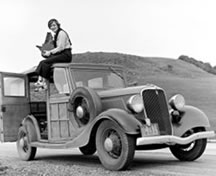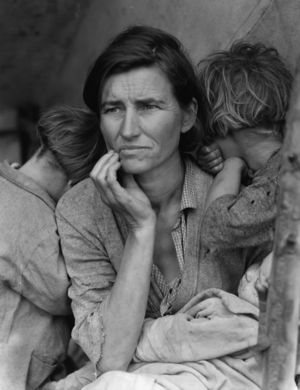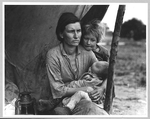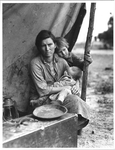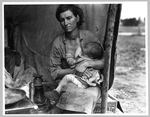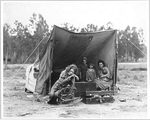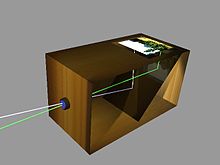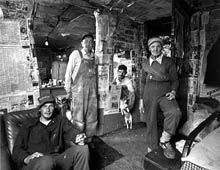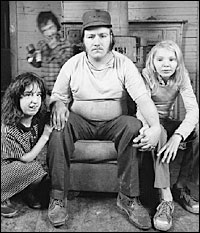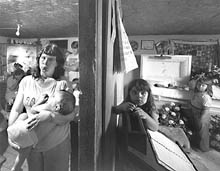
Photography and Six Perspectives
Photography
The Photograph : Migrant Mother
|
Florence Owens Thompson
|
Photography and the Six Perspectives
- Photography ranges from a picture taken by an ordinary person using a smartphone to a professional with the most expensive equipment
- Photography expresses emotion, illustrates lives, persuades, influences
Personal Perspective
- High quality pictures can easily be taken
- There is a difference between what people remember about a scene and how it photographs
- People behave differently in front of a camera
- Meaning imposed on a photograph comes from the view -photos are used to show where you have been, who you were with, who you have loved, to remember events, things you've owned, to remind you of a state of mind- the photographer is excluded from the scene. Photographs can be among our most important possessions.
- Photography teaches the photographer to be a keen observer, but also to participate
Historical Perspective
see a brief history of Photography http://www.youtube.com/watch?v=S-7_FciNaqs
Camera Obscura
- Aristotle wrote about light that allows an upside down view of the world through a pin hole in one wall of a dark chamber, 1000 years before the camera.- camera obscura
Camera Obscura: "The device consists of a box or room with a hole in one side. Light from an external scene passes through the hole and strikes a surface inside, where it is reproduced, upside-down, but with color and perspective are preserved. The image can be projected onto paper, and can then be traced to produce a highly accurate representation." ( source: wikipedia) Painters used camera obscura to trace sketches of scenes on paper to be filled in later with paint |
Source: Wikimedia Commons |
Joseph Niepce 1827- The First Permanent Photograph - Heliography
- Joseph Niepce in 1827 produced the first permanent photograph that can still be viewed -he was trying to improve the lithographic process and combined the camera obscura with photosensitive paper- he named his process heliography-the public learned about it after his death- his process was not practical see a video at http://www.youtube.com/watch?v=78KfCkCN3ck
Heliographs - a brief history of photography from PIX IN MOTION by Leo Bar on Vimeo.
Louis Daguerre- Daguerreotype
- Louis Daguerre in 1837 used Niepce's work to produce the first practical photographic process called the Daguerreotype -see a video https://youtube.com/watch?v=OIfbspXyJgY and also http://www.youtube.com/watch?v=cmm90yhhuJM
- Daguerre created images on silver-plated copper, coated with silver iodide and "developed" with warmed mercury; He is awarded a state pension by the French government in exchange for publication of methods and the rights by other French citizens to use the Daguerreotype process.
- Below to left is a Daguerreotype of Deguerre
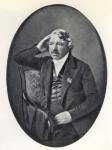 Daguerreotype |
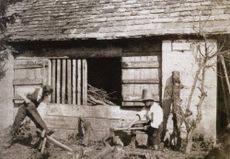 Collotype |
Henry Fox Talbot- First Permanent Images with Negatives-Calotype
- At the same time Henry Fox Talbot created permanent
(negative) images using paper soaked in silver chloride and fixed with
a salt solution. Talbot created positive images by contact printing
onto another sheet of paper and patented the process in 1841 under
the name Calotype. His pictures were not as clear
as Daguerreotypes but it was first time "positive" and "negative" were
used.
Frederick Scott Archer-Wet Collodion
- 1851: Frederick Scott Archer improves photographic resolution with Wet Collodion photography - much cheaper than daguerreotypes, the negative/positive process permitted unlimited reproductions, and the process was published but not patented.
- Archer never profited from his invention
The Collodion Process
James Clerk-Maxwell - Color Photography-Color Separation
- 1861 Scottish physicist James Clerk-Maxwell demonstrates a color photography system involving three black and white photographs, each taken through a red, green, or blue filter. The photos were turned into lantern slides and projected in registration with the same color filters. The first colour slide. This is the "color separation" method.
- Lumiere Brothers- Autochrome, 1903 -Principal color photography process in use before the advent of subtractive color film in the mid-1930s.
- Eadweard Muybridge 1878 Motion Study photographs
George Eastman - Introducing Amateur Photography
- 1871: Richard Leach Maddox, an English doctor, proposes the use of an emulsion of gelatin and silver bromide on a glass plate, the "dry plate" process sparking the invention of motion picture film- his process made amateur photography possible when George Eastman invented cameras with gelatin dry plate films in rolls
- in1888 Eastman introduced his $25 (about $500 today)Kodak camera. His jingle "You press the button and we do the rest" 100pictures were included, when all taken the camera was mailed for developing and reloading. By 1900 cameras were $1 (about $20 today )
- see a video about Eastman House http://www.youtube.com/watch?v=NKbLeFf6QZY
- Edwin Land in 1948 introduced 60 second instant photography
- in 1984 Sony introduced an electronic still video camera- Mavica-and digital photography -25 colour images can be recorded on a disc and played back on computer
- Digital photography meant immediate delivery of photos - instant photojournalism
Technical Perspective
- Lens types: wide angle produces expansive scene-setting; normal mimics human eye; telephoto give close up
- Lens opening; amount of light is regulated by lens opening called aperture =large lens opening is needed for low light
- Shutter speed- slow will cause blur if there is motion- faster stops camera shaking during exposure
- Lighting- lighting that comes from available sources-natural-available light includes sun and light bulb, candle,etc.- lighting affects mood- low light mysterious, backlight separates person from background- side light give subject harsh. rugged feel
Ethical Perspective
- Problems making news event public in newspapers, magazines, TV (privacy, violence to victim, manipulation)
Victims of Violence
- Violence and tragedy has always been important to journalism
- Think of the impact of gruesome images
- For example, see a video on the Kent State Massacre http://www.youtube.com/watch?v=vyzoNCJvy4c
- Journalist has duty to report objectively, editors need to be mindful of emotional content that can upset reader; however, what the papers won't show will probably show up online.
- The argument to publish raw photographs of war is that they're necessary to make people aware of the reality, the real damage war has on cultures and human bodies.
- The Vietnam war was called the first war that was televised. Many say that the fact that pictures of the results of war on television and in newspapers had a lot to do with war protests and the eventual US withdrawal. See the Vietnam and Kent State photos that changed the world at Vietnam (inside link)
- Dennis Dunleavy In The Next Revolution will be Digital said ,
"The next revolution may not be televised by embedded journalists, but rather by an army of citizen soldiers carrying inexpensive digital "happy snap" cameras. The images, which show U.S. military guards posing over the naked bodies of prisoners like freshman at a college frat party, signify a small victory for the institution of democracy and the right of dissent....
The next revolution will be digital and is being pinged across the email right now.
Despite the "clear and present" danger for altering digital images for political or economic gain, the sheer number and variety of sources of photographs coming out of Iraq suggests the potential of the digital camera's capacity for carrying a burden of truth. Digital imagery is changing the way we see the world, in all of its splendor as well as all of its horror. The irony of the Iraqi prisoner abuse photos illustrates that democratic values and civics are alive and well, despite efforts to sanitize the truth." (see the full article and photos at http://www.digitaljournalist.org/issue0405/dunleavy.html )
- For more on the controversy on Iraq and images see http://www.camerairaq.com/ -a project by Carleton College's Cinema & Media Studies Department to gather news and commentary about public and personal photographic image practices associated with the War of Images in the Middle East
- During the war in Iraq Journalists were embedded with military troops. When a journalist is being protected by troops can his/her coverage be objective? Some say the government of the US staged managed the war, by controlling what the media saw. George W. Bush's "Top Gun" landing on the deck of the carrier Abraham Lincoln with Mission Accomplished in the background in 2003 will be remembered as one of the most audacious moments of presidential theater in American history. Millions of dollars is spent every year for staged photos op.
June 2006 US Military showing pictures of Abu Musab al-Zarqawi, the leader of al-Qaida in Iraq Why does US government object to other media showing their war dead but then show al_Zarqawi dead, or Sadam Hussein's dead sons? |
- Antonia Zerbisias In the Star July 25, 2006 talked about how even though reporters are not being restricted in Israel and Lebanon in the current war, reporters were self censoring and newspapers and television reporters werr reluctant to show the real images of war. In spite of this, the internet is getting these pictures out through the so called "blogosphere" --see Self Censorship to read more
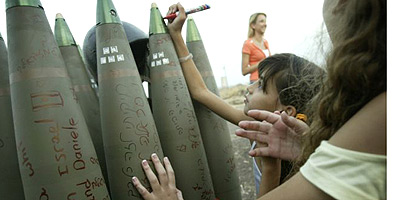
This photograph of Israeli children writing messages
to children of Lebanon
on artillery shells bound for targets in Lebanon has caused outrage and has
not been seen in regular media
- in September 2006 Crocodile Hunter Steve Irwin was killed by a stingray while he was being filmed. He has always told his crew to keep on filming no matter what. Some of his crew believe he would have wanted the film of his death to be shown. Read more at Debate over footage of Death (inside link) Who has the right o choose if this is shown?
- September 11, 2006 marked the 5th anniversary of the terrorist act on the Twin Towers but there was still controversy on what images should be shown. Read more at Images Tell The Story (inside link)
- The Globe and Mail published an image of a Ukraine protestor enveloped in flames on the cover of their February 19th, 2014 newspaper. A number of subscribers were upset by the picture and the fact that they were not even told what had happened to the man in the photo. The public editor, Sylvia Stead defended the use of the photo saying that images such as this are critical to understanding events. She pointed out the potential fro such photos to provoke change. As examples, she mentioned the photo of the Kim Phuc running from Napalm during the Vietnam war, and images of the Twin Towers during the 9/11 terrorist attack. See some of the images they posted on their website here http://www.theglobeandmail.com/news/world/in-pictures-graphic-images-from-ukraines-violent-clashes/article16939091/ and read The editors comments here http://www.theglobeandmail.com/community/inside-the-globe/public-editor-every-picture-tells-a-story-some-of-them-disturbing/article17039585/- What ethical perspective does this represent?
On camera slayings of two journalists in Virginia during a morning television show in the summer of 2015, show the dangers of live television.
A picture of a small boy washed on shore on a Turkish beach, triggered worldwide attention to the refugee crisis. We might conclude that the world has become a much more violent place when in fact many who study worldwide violence report that the world is more peaceful. The change is the technology that make sharing of images ubiquitous.
(See an interesting article 2015 How should news organizations handle graphic content in social media age.)
Click to read about the image of 3 year old Aylan Kurdi and the effect of the image
Right to Privacy
- In July of 2006 the British public and the sons of Diana were outraged when Italian magazine Chi published death scene photographs of Princess Diana- see Outrage (inside link)
- Many were outraged when newspapers and magazines printed picture of people falling from the World Trade center
- Throughout history of photography there has been a concern for the right of privacy of an individual being photographed without their knowledge
- A woman in Florida kidnapped by her husband and stripped sued a newspaper for the pictures of her rescue. She was covered by a small towel, Her award of $10,000 was overturned
- US military under George Bush banned pictures of returning dead- they say it's privacy, some say it's to keep it out of public eye
- Privacy laws are stricter for common person than for a celebrity
Manipulation
The accidental tourist guy?
Did a tourist capture this picture of a plane approaching the World Trade Center?
see Urban Legends pages for the answer http://www.snopes.com/rumors/crash.htm
and see a video about him here http://www.youtube.com/watch?v=i35L8ckA_Io
- Daguerreotypes were coloured in with brush and ink; engravers altered content of photos; subjects were added and subtracted in civil war photos; wedding photos are corrected to remove moles and blemishes, ads combine all manner of images; usually the digital image is altered but not the negative- when question of manipulation arises the neg can be consulted- digital photos don't have that option
- See famous manipulated photos at Photo Ethics http://www.sree.net/teaching/photoethics.html
- See History of Manipulation at http://www.cs.dartmouth.edu/farid/research/digitaltampering/
- in August of 2006 before her debut as news anchor at CBS, CBS doctored a photo of Katie Couric to make her look slimmer in its Watch Magazine. see picture below
- See Maria Popova's Brain Pickings overview of the history of photo manipulation Faking It: A Visual History of 150 Years of Image Manipulation Before Photoshop http://www.brainpickings.org/index.php/2012/10/23/faking-it-met/

|
 |
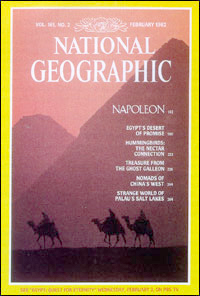 |
-in February 1982: The pyramids were moved closer together to accommodate this vertical National Geographic cover. |
Cultural Perspective
Shelby Lee Adams: Documentary portrayal or voyeur's manipulation of culture?
- Study of photos of a certain time tells much about the culture
- Shelby Lee Adams documents the remote rural communities of Appalachia in Kentucky; his photographs show what he calls real people in their real lives; people from the south accuse him of showing a negative stereotype that exploits the people. Many of his photographs are staged but he argues these are the real people and this is where and how they live. Is he documenting a culture or manipulating a group of people and putting the viewer in the position of voyeurs? A documentary The True Meaning of Pictures documents his photography with this group over the years read more and see pictures at the links at True Meaning
- See a brief video on Shelby Lee Adams http://youtube.com/watch?v=g6PIGX7SXmQ
- see Shelby Lee Adams blog http://shelby-lee-adams.blogspot.com/
- Early photos were portraits of famous and ordinary people
- Many early painters feared photography would replace painting so some artists became photographers mimicking painting
- see Oscar Rejlander's famous Two Ways of Life for an example http://www.fotoart.gr/photography/history/historyphotos/onephotoonestory/thetwowaysoflife.htm
- Photographers also took pictures of natural scenes shaping the way people saw beauty and nature
- Many photographers view photography as an art
- Others use photography to document the social world to convey emotional messages- documenting child labour, conditions of poor
- Today facebook's timeline can capture every moment of a child's life even before birth
Critical Perspective
- Photography helped to educate people about social problems- It created interest which lead people to read about places, people, things
- Governments democratic and totalitarian have used images to persuade
- Photos have been used to entertain and educate, to provide historical information; today's potential to manipulate photos undermines the credibility
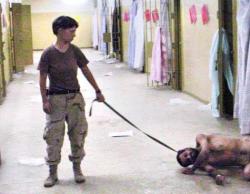
Lynndie England at Abu Ghraib
____________________________________________________
Sources/ Resources
100 Photographs that Changed the World http://www.digitaljournalist.org/issue0309/lm_intro.html
Adams, Shelby Lee http://www.edelmangallery.com/adams.htm
Adams, Shelby Lee Blog http://shelby-lee-adams.blogspot.com
American Photography: A Century of Images http://www.pbs.org/ktca/americanphotography
Brutal Images of Syrian boy drowned off Turkey must be seen activists say. (Sept 2, 2015) New York Times.
Curto, Jeff. History of Photography course http://www.cod.edu/photo/curto/1105/#PhotoHist
Daguerreotype process http://www.photohistory-sussex.co.uk/dagprocess.htm
Dart center for Journalism and trauma Media Panel Debates Use of Violent Images
15 April, 2004 lhttp://www.dartcenter.org/articles/special_features/4_14_panel.html
Ethics Digital Journalist http://www.digitaljournalist.org/issue0602/ethics.html
Escobar, Aaron. (24 Sept. 2015) How should news organizations handle graphic content in the social media age. Columbia Journalism Review. http://www.cjr.org/analysis/this_summer_saw_the_on-camera.php
FSA Photography http://www.oberlin.edu/library/papers/honorshistory/2001-Gorman/FSA/default.html
History of Photography Timeline http://www.photo.net/history/timeline
History of photo manipulation http://www.cs.dartmouth.edu/farid/research/digitaltampering/
Journalism Ethics cases Indiana University Photo Ethics manipulation http://www.journalism.indiana.edu/gallery/Ethics/#photos
Lester, Paul Martin, (2013) Visual Communication: Images with Messages, Wadsworth Publishing.
Faking images in Photojournalism http://commfaculty.fullerton.edu/lester/writings/faking.html
Florence Owens Thompson https://en.wikipedia.org/wiki/Florence_Owens_Thompson
Interview with Dorothea Lange http://artarchives.si.edu/collections/oralhistories/transcripts/lange64.htm
Images. Power and Politics http://www2.sjsu.edu/faculty/wooda/171/171syllabus2chapter1.html
Images of the Great depression Essay http://www.oah.org/pubs/magazine/greatdepression/stevens-fogel.html
Images of the Depression http://www.oah.org/pubs/magazine/greatdepression/stevens-fogel-photos.html
Iraq and images see http://www.camerairaq.com/ -a project by Carleton College's Cinema & Media Studies Department to gather news and commentary about public and personal photographic image practices associated with the War of Images in the Middle East
Manipulated Photos Photo Ethics http://www.sree.net/teaching/photoethics.html
Photojournalism Ethic guidelines http://www.journalism.org/resources/tools/ethics/codes/photojournalism.asp
Pictures that Lie CNET http://news.com.com/2300-1026_3-6033210-1.html?tag=ne.gall.pg
Popova, Maria (Brain Pickings) Faking It: A Visual History of 150 Years of Image Manipulation Before Photoshop http://www.brainpickings.org/index.php/2012/10/23/faking-it-met/
Rejlanders, Oscar. Two Ways of Life http://www.fotoart.gr/photography/history/historyphotos/onephotoonestory/thetwowaysoflife.htm
Salon Attack of the celebrity vacuum-cleaner-salesman ghouls Dead spokespeople in ads http://www.salon.com/july97/media/media970708.html
Should newspapers show us violent images from Iraq? http://www.slate.com/id/2098283/
The Wizard of Photography PBS https://www.pbs.org/wgbh/amex/eastman/timeline/index.html
Timothy, Eva, Illuminating Photography: From Camera Obscura to Camera Phone, TEDed http://www.youtube.com/watch?v=XaGUL8B-BrE
What can companion pictures tell http://historymatters.gmu.edu/mse/Photos/question4.html#alys
